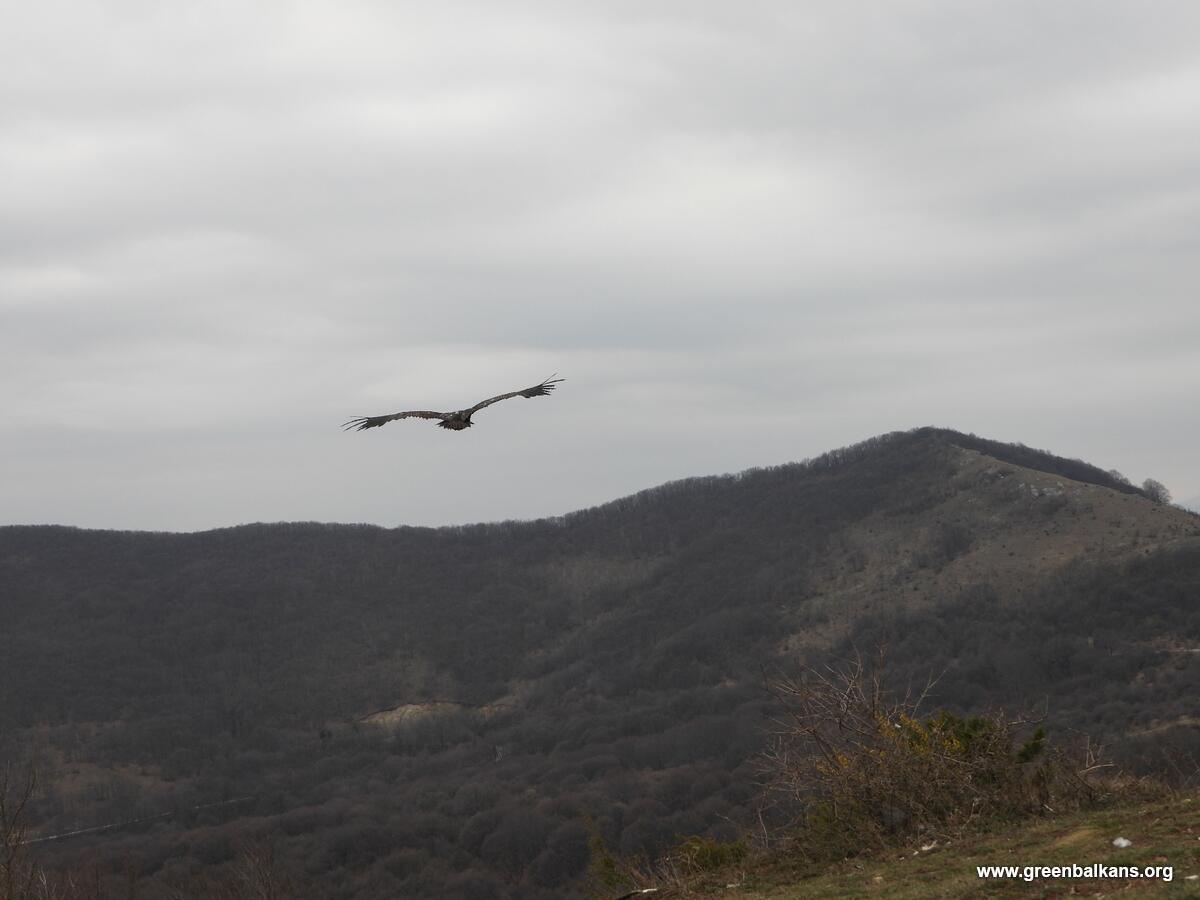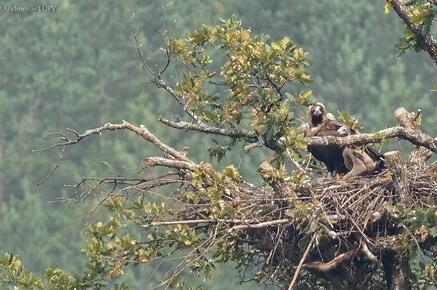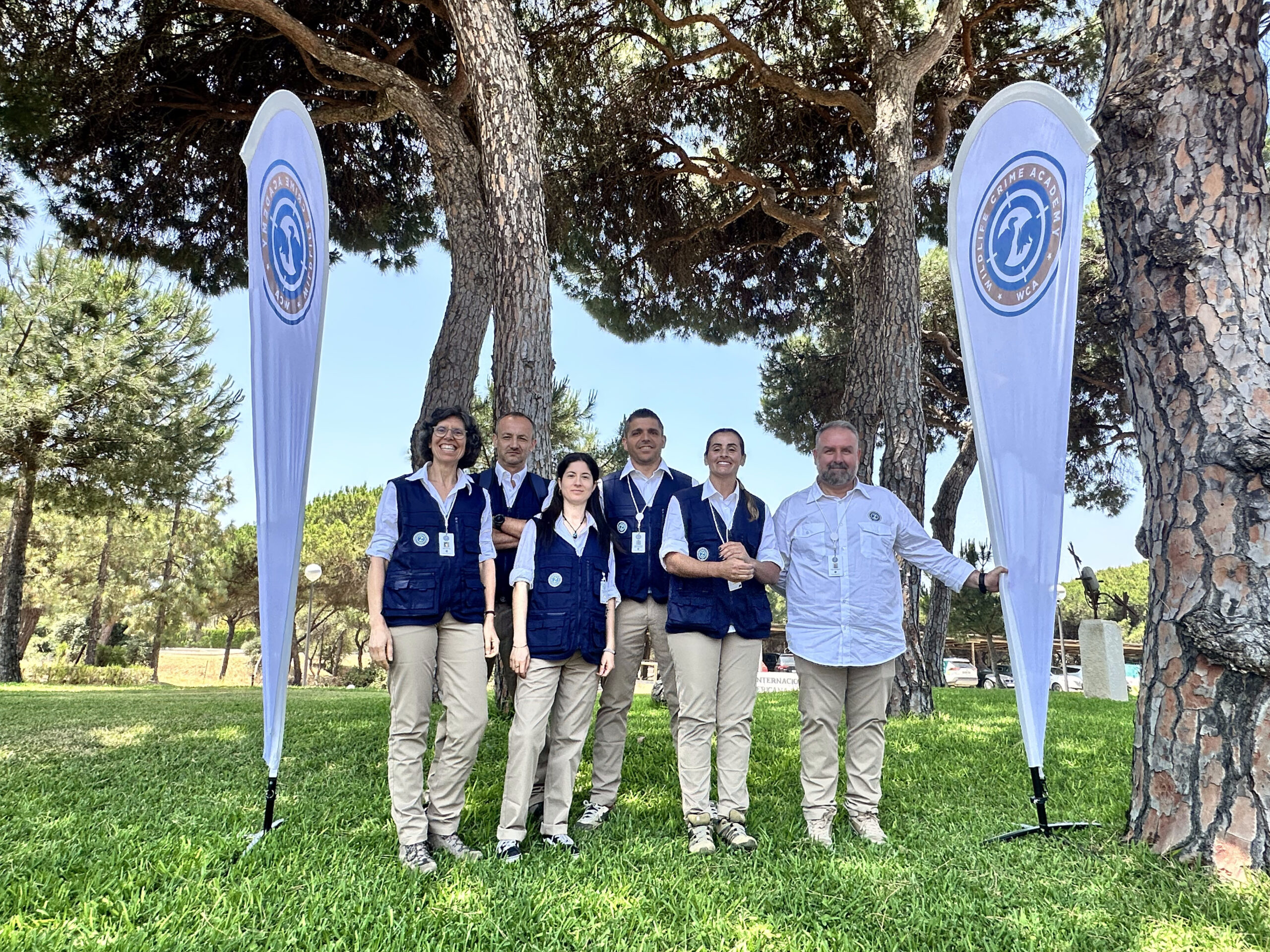The “tagging season” of Cinereous Vulture (Aegypius monachus) chicks ended at the beginning of August. In 2024, the LIFE Aegypius Return project tagged 19 Cinereous Vulture chicks in the nest, in addition to the 15 tagged in 2023.

A year full of news
The LIFE Aegypius Return project had planned to tag 30 chicks in the nest: 15 in 2023 and another 15 in 2024. However, the positive results that the species has shown have changed these plans.
The project team distributes the tagging operations – and the available equipment – through the species’ various breeding colonies in Portugal. The four previously known colonies have shown signs of expansion, and a fifth colony has been confirmed this year, strengthening hope for the species’ recovery in Portugal.
Douro International, the most isolated colony
The Douro International breeding colony is the most isolated in the country, situated more than 100 kilometres from the nearest colony in Spain. This isolation, coupled with its small number of breeding pairs, makes it highly vulnerable, as any random event, such as a forest fire, could have devastating and difficult-to-reverse consequences. The colony was established in 2012 with a nesting pair that failed to breed at that time. The number of pairs only increased to two in 2019 and to three in 2023, so it was with surprise that eight breeding pairs were registered this year: five on the Portuguese side and three on the Spanish side. Three of the hatchlings were tagged there this year, one of them in the Arribes del Duero Natural Park in Spain.
Tagging operations on the steep cliffs of the Douro canyon are particularly challenging due to the difficulty in accessing the nests, and require the collaboration of various specialists, including professional climbers.
These demanding works were possible thanks to a cross-border collaboration involving Palombar, Arribes del Duero Natural Park; Junta de Castilla y León; Universidad de Oviedo; Liga para a Protecção da Natureza (LPN); Institute for the Conservation of Nature and Forests (ICNF) – North Regional Delegation; the veterinary team from the Wild Animal Recovery Centre at the Veterinary Hospital of the University of Trás-os-Montes and Alto Douro; and Javier de la Puente, a bird conservation specialist and Palombar’s collaborator.


Malcata, a remarkable expansion
The Serra da Malcata colony was established in 2021, with four known breeding pairs. In 2023 the colony increased to an impressive number of 14 breeding pairs, and in 2024 the figure continued to rise, to 19. This led the team to plan increasing the number of birds tagged this year to six.
However, one of the chicks identified for tagging was smaller and possibly younger than expected. Biological samples were collected, it was hydrated, ringed, and returned to the nest to continue under parental care. It will now be monitored from a distance and may eventually be equipped with the transmitter when it grows larger.
In Malcata, five chicks were tagged this season. The challenge of these tagging operations lies in the difficulty in reaching the nest and the height of the trees on which they are built. To plan a tagging session, it is necessary to ensure not only that access to the chick in the nest is possible, but also that the young bird is at the appropriate age and weight to receive the GPS/GSM transmitter. This may be challenging, as all observations are made from a long distance to avoid disturbing the birds.
Tagging operations in the Serra da Malcata Nature Reserve had the indispensable collaboration of the biologist Carlos Pacheco, Associação Transumância e Natureza/Faia Brava (ATN), Rewilding Portugal, ICNF – Centre Regional Delegation, LPN and the Vulture Conservation Foundation (VCF).

Tejo International: offspring of the founding pair of the largest colony in Portugal was tagged
The establishment of the Tejo Internacional breeding colony in 2010 marked the official recolonisation of Portugal by the Cinereous Vulture, after around 40 years of absence as a breeding species. Since then, this colony has been closely monitored and, by 2023, it was home to more than half of the country’s breeding population. This year, the number of nesting pairs increased to 61 (15 of which in Spanish territory), and it was possible to tag seven chicks. Of these, one is of known lineage! Aravil‘s son was tagged, one of the offspring of the colony’s two founding pairs in 2010.
These taggings were made possible thanks to the collaboration of the Portuguese Society for the Study of Birds (SPEA); Quercus and the Centre for the Study and Recovery of Wild Animals (CERAS); LPN; ICNF – Centre Regional Delegation; VCF, the police Guarda Nacional Republicana (GNR) with its Service for the Protection of Nature and the Environment (SEPNA – Núcleo de Proteção Ambiental, Destacamento Territorial de Idanha-a-Nova) and the Cynotechnical Intervention Group (GIC) of the Idanha-a-Nova Intervention Unit; and the ornithologist/researcher Alfonso Godino; and were supported by the Hawk Mountain Sanctuary and ENDESA. The tagging work was also accompanied by the Idanha-a-Nova Municipal Council, through the Municipal Veterinary Medical Office and the Educational Action Service – Environmental Area.


Herdade da Contenda, the colony that expands eastwards
This breeding colony was established with two nesting pairs in 2015, following the conservation efforts of the LIFE Habitat Lince Abutre project, led by LPN. Since then, it has gradually grown and this year it has recorded at least 20 breeding pairs – five of which established in Spanish territory, three more than last year. Although ecologically all these birds belong to the same colony, from an administrative and conservation point of view, this apparent expansion brings some additional measures under a cross-border collaboration.
In July, three chicks were tagged at Herdade da Contenda, thanks to the collaboration of LPN, the ICNF – Alentejo Regional Delegation, and Herdade da Contenda, e.m. – entities that have been jointly monitoring the colony –, VCF, ATN and Carlos Pacheco. The work was also attended by representatives of Moura City Council, which owns the Herdade da Contenda estate.

The fifth and most recent breeding colony in Vidigueira
This breeding colony, discovered in June by the ICNF in Vidigueira (Southern Portugal), is the most recent and the smallest in the country. It is also the westernmost known colony in the species’ global distribution area, and the first deep inside Portuguese territory.
Four Cinereous Vulture nests were detected, but only one with a breeding pair, whose chick was promptly tagged by a team made up of members of the ICNF – Alentejo Regional Delegation, the LPN and the tagger, Carlos Pacheco.


Tagging Cinereous Vultures to reduce their mortality rate
Tagging is a complex process that requires the participation of accredited specialists from various fields: biologists, veterinarians, authorities, climbers… The birds are subjected to a veterinary examination and biological samples are taken that will allow to understand the vulture’s health condition and establish reference values for the species – information that is of great relevance to the veterinary teams and recovery centres that treat Cinereous Vultures. They are then marked with a metal ring with a unique identification code, a colour ring that allows the bird to be identified from a distance, and a GPS/GSM transmitter, which provides the location of the bird, for its continuous monitoring. The device, which weighs only around 50 grams, enables the monitoring of the bird’s movements and behaviour. Any anomalies can be quickly detected, a team can go to the location and, if necessary, take an injured bird to a wildlife recovery centre. This swift action makes it possible to rescue and care for vultures that would otherwise probably die in the field. For an endangered species with a relatively small population, the survival of each individual is crucial for the species’ recovery.
In total, the LIFE Aegypius Return project plans to tag 60 Cinereous Vultures. In addition to tagging chicks in the nest, the project includes attempting to capture adults, such as Aravil, and the soft release of rehabilitated juveniles after their acclimatisation in Douro International.
The LIFE Aegypius Return partners would like to thank all the people and organisations that have collaborated in monitoring and tagging in the five colonies.
The project teams will continue to monitor the chicks until they leave the nest and become fully independent, which should happen by late August or early September. At that point, it will also be possible to finalise and disclose the full results of this breeding season. Follow our project website or the partners’ social networks.

The LIFE Aegypius Return project is co-financed by the European Union’s LIFE programme. Its success depends on the involvement of all the relevant stakeholders, and the collaboration of the partners, the Vulture Conservation Foundation (VCF), the coordinating beneficiary, and the local partners Palombar – Conservação da Natureza e do Património Rural, Herdade da Contenda, Sociedade Portuguesa para o Estudo das Aves, Liga para a Protecção da Natureza, Associação Transumância e Natureza, Fundación Naturaleza y Hombre, Guarda Nacional Republicana and Associação Nacional de Proprietários Rurais Gestão Cinegética e Biodiversidade.



